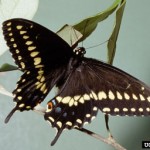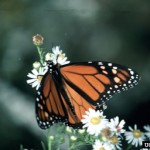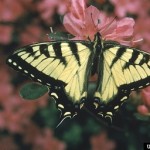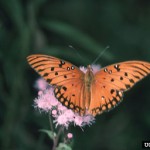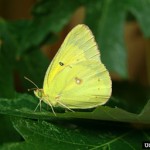San Antonio Express News
GARDENING, Etc
Sunday, November 23, 2003
By Nathan Riggs
- Black Swallowtail Photo: Gerald J. Lenhard, LSU;http://www.insectimages.org
- Monarch Jerry A. Payne, USDA ARS, www.insectimages.org
- Tiger Swallowtail Edward L. Manigault, Clemson University www.insectimages.org
- Gulf Fritillary Jerry A. Payne, USDA ARS, www.insectimages.org
- Sulpher Butterfly Joseph Berger www.insectimages.org
Thanksgiving arrives this week, and you sure couldn’t tell by looking at the weather so far this fall! Daytime highs have hovered near 80 degrees for the majority of days and there has been plenty of sunshine to compliment the sporadic bouts of rain and clouds. While this type of weather makes it somewhat difficult to get into the spirit of the holidays, many insect populations are really enjoying things so far.
Many gardeners who still have flowers blooming have called the Extension office to convey their enjoyment at clouds of butterflies and are appreciating their colorful flights through the garden. Many of the swallowtail butterflies including the black , pipevine, tiger and giant swallowtails are still present in good numbers. Other common species hanging around are the sulphur, gulf fritillary and queen butterflies. The queen butterfly is a cousin to the ever popular monarch butterfly. Most of the local and migrating monarchs have moved on toward the winter hibernation grounds in Central Mexico. A few folks still have caterpillars feeding in their herb gardens and on passionvine. These caterpillars will form chrysalides and spend the winter transforming to butterflies and waiting for spring.
Other insects are enjoying the warm weather, too. Honeybees are very active on warm days, seeking out sources of sugar for their hives. Frequently, these sugar sources come in the form of old carbonated drinks in trash cans or at picnics. There aren’t too many nectar-bearing flowers left except for honeysuckle, salvia and firebush. Remember that bees are not protective of their food–only their hive. This is true of regular honeybees and Africanized honeybees.
Insects in general tolerate temperatures into the upper 50’s and as high as 100 in the summer. Once autumn temperatures drop below 60 consistently, most of our local insects go into hibernation mode and only become active on warmer days. If you have wasp nests, beehives or yellowjacket nests in sensitive areas, cool mornings or evenings are the ideal times to deal with their removal. Removing them, relocation or destroying the nests are among popular ways chosen by homeowners.
In addition to the beneficial insects mentioned so far, don’t forget that there are a few pests that also love warm fall weather. Cabbage looper caterpillars are present in the fall and will heartily nibble on cabbage, lettuce, broccoli and cauliflower until temperatures become too cool for them to continue. Insecticides containing the organic ingredient Bt will do a wonderful job on these and any other nuisance caterpillars at this time.
All of us are looking forward to the aromas, tastes and sights of the holiday season. The sight of a Thanksgiving feast is tempered only by the fact that we might be wearing shorts and short sleeves instead of a sweater and pants due to the cool, crisp days we hope are coming. To our local insects, flowers, herb gardens and vegetable gardens represent that Thanksgiving feast. Thanks to Mother Nature and the warm weather, all are satisfied in some way.
Nathan Riggs is a certified Entomologist and Extension Agent-IPM with Texas Cooperative Extension in Bexar County. For more information call (210) 467-6575.
